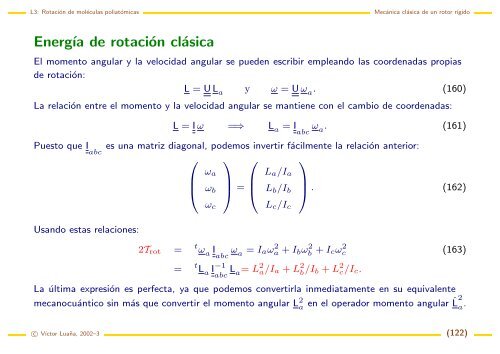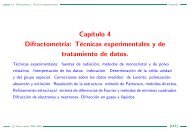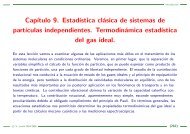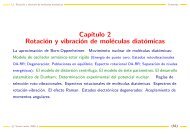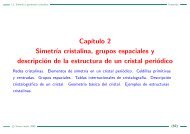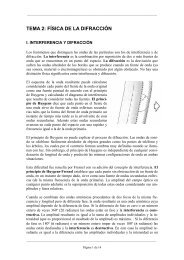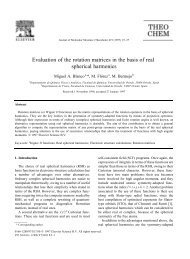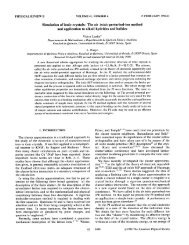Capīıtulo 3 Rotación de moléculas poliatómicas
Capīıtulo 3 Rotación de moléculas poliatómicas
Capīıtulo 3 Rotación de moléculas poliatómicas
Create successful ePaper yourself
Turn your PDF publications into a flip-book with our unique Google optimized e-Paper software.
L3: <strong>Rotación</strong> <strong>de</strong> <strong>moléculas</strong> <strong>poliatómicas</strong> Mecánica clásica <strong>de</strong> un rotor rígido<br />
Energía <strong>de</strong> rotación clásica<br />
El momento angular y la velocidad angular se pue<strong>de</strong>n escribir empleando las coor<strong>de</strong>nadas propias<br />
<strong>de</strong> rotación:<br />
L = U L a y ω = U ω a . (160)<br />
La relación entre el momento y la velocidad angular se mantiene con el cambio <strong>de</strong> coor<strong>de</strong>nadas:<br />
L = I ω =⇒ L a = I abc ω a . (161)<br />
Puesto que I abc es una matriz diagonal, po<strong>de</strong>mos invertir fácilmente la relación anterior:<br />
Usando estas relaciones:<br />
⎛<br />
⎜<br />
⎝<br />
ωa<br />
ωb<br />
ωc<br />
⎞<br />
⎟<br />
⎠ =<br />
⎛<br />
⎜<br />
⎝<br />
La/Ia<br />
Lb/Ib<br />
Lc/Ic<br />
⎞<br />
⎟<br />
⎠ . (162)<br />
2Trot = t ω a I abc ω a = Iaω 2 a + Ibω 2 b + Icω 2 c (163)<br />
= t L a I −1<br />
abc L a = L2 a/Ia + L 2 b /Ib + L 2 c/Ic.<br />
La última expresión es perfecta, ya que po<strong>de</strong>mos convertirla inmediatamente en su equivalente<br />
mecanocuántico sin más que convertir el momento angular L 2 a en el operador momento angular ˆ L 2<br />
a .<br />
c○ Víctor Luaña, 2002–3 (122)


